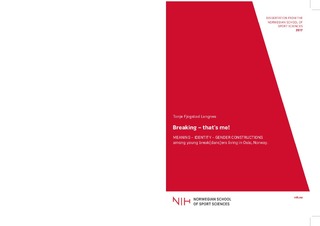| dc.contributor.author | Langnes, Tonje Fjogstad | |
| dc.date.accessioned | 2017-08-07T11:36:55Z | |
| dc.date.available | 2017-08-07T11:36:55Z | |
| dc.date.issued | 2017 | |
| dc.identifier.isbn | 978-82-502-0541-3 | |
| dc.identifier.uri | http://hdl.handle.net/11250/2450032 | |
| dc.description | Avhandling (doktorgrad) - Norges idrettshøgskole, 2017 | nb_NO |
| dc.description.abstract | In a rapidly changing world characterized by increased ethnic diversity, successful integration depends (among other factors) on social interaction among people. Hence, there is a need for cross-cultural meeting points. Breaking [breakdance] is historically linked to a black, urban street context and has evolved into a global phenomenon with adherents throughout the world. This dissertation investigates the meaning of breaking in the lives of young people living in Oslo, Norway. Considering breaking as a subculture and alternative sport, the dissertation may contribute to the understanding of young people’s choices – their construction of meaning, identity and gender within this activity. Theoretically, the study draws on symbolic interactionism to understand how young breakers in Oslo define their experiences and give meaning to their identities, behaviors, realities and social interactions. However, to address social structure and power, gender perspective has been applied. As a social construction, gender is constantly reconstructed through social interaction, and the dissertation explores how gender influences the breakers’ experiences and how breaking is a site for negotiating gender ideology and power relations. Methodologically, the study uses a qualitative research strategy to create an in-depth understanding of the social practices of breaking. Empirically, the dissertation draws on ethnographic data generated through fieldwork and interviews. The fieldwork involved participant observation four days a week from August 2011 to March 2012. The fieldwork was followed by 17 qualitative interviews with 6 female and 11 male breakers, who reflected the observed diversity within the subculture of breaking. | nb_NO |
| dc.description.abstract | Paper I: Langnes, T.F. & K. Fasting (2014) Identity constructions among breakdancers. International Review for the Sociology of Sport. Published online before print 19 March 2014. doi: 10.1177/1012690214526402. Print: International Review for the Sociology of Sport. May 2016, 51 (3), pp. 349–364. | nb_NO |
| dc.description.abstract | Paper II: Langnes, T.F. & K. Fasting (2014) The construction of meanings in breaking. Insights from breakers in Oslo. Nordic Journal of Dance. 5(2), pp. 22–35. | nb_NO |
| dc.description.abstract | Paper III: Langnes, T.F. & K. Fasting (2017) Gender constructions in breaking. Sport in Society. Published online before print 6 February 2017. doi: 10.1080/17430437.2017.1284809, pp. 1-16. | nb_NO |
| dc.description.abstract | Paper IV: Langnes, T.F. (2017) Masculinity constructions among Norwegian male break(danc)ers. Submitted to European Journal for Sport and Society, pp. 1-29. | nb_NO |
| dc.language.iso | eng | nb_NO |
| dc.subject | nih | nb_NO |
| dc.subject | doktoravhandlinger | nb_NO |
| dc.subject | break-dance | |
| dc.subject | dans | |
| dc.subject | ungdom | |
| dc.subject | identitet | |
| dc.subject | kultur | |
| dc.subject | kjønnsroller | |
| dc.subject | doktoravhandlinger | |
| dc.title | Breaking - that's me!: meaning, identity, gender constructions among young break(danc)ers living in Oslo, Norway | nb_NO |
| dc.type | Doctoral thesis | nb_NO |
| dc.description.localcode | Seksjon for kroppsøving og pedagogikk / Department of Physical Education | nb_NO |
